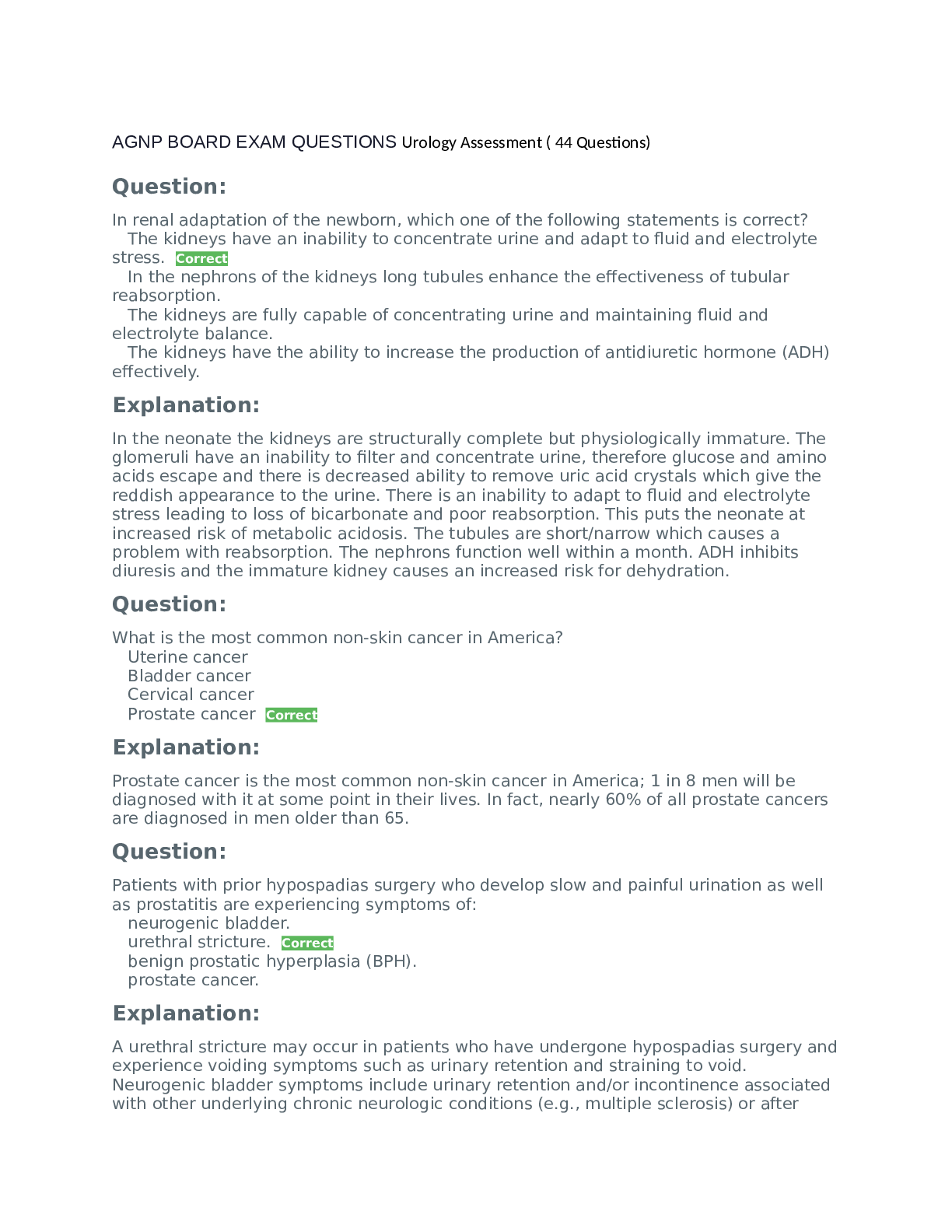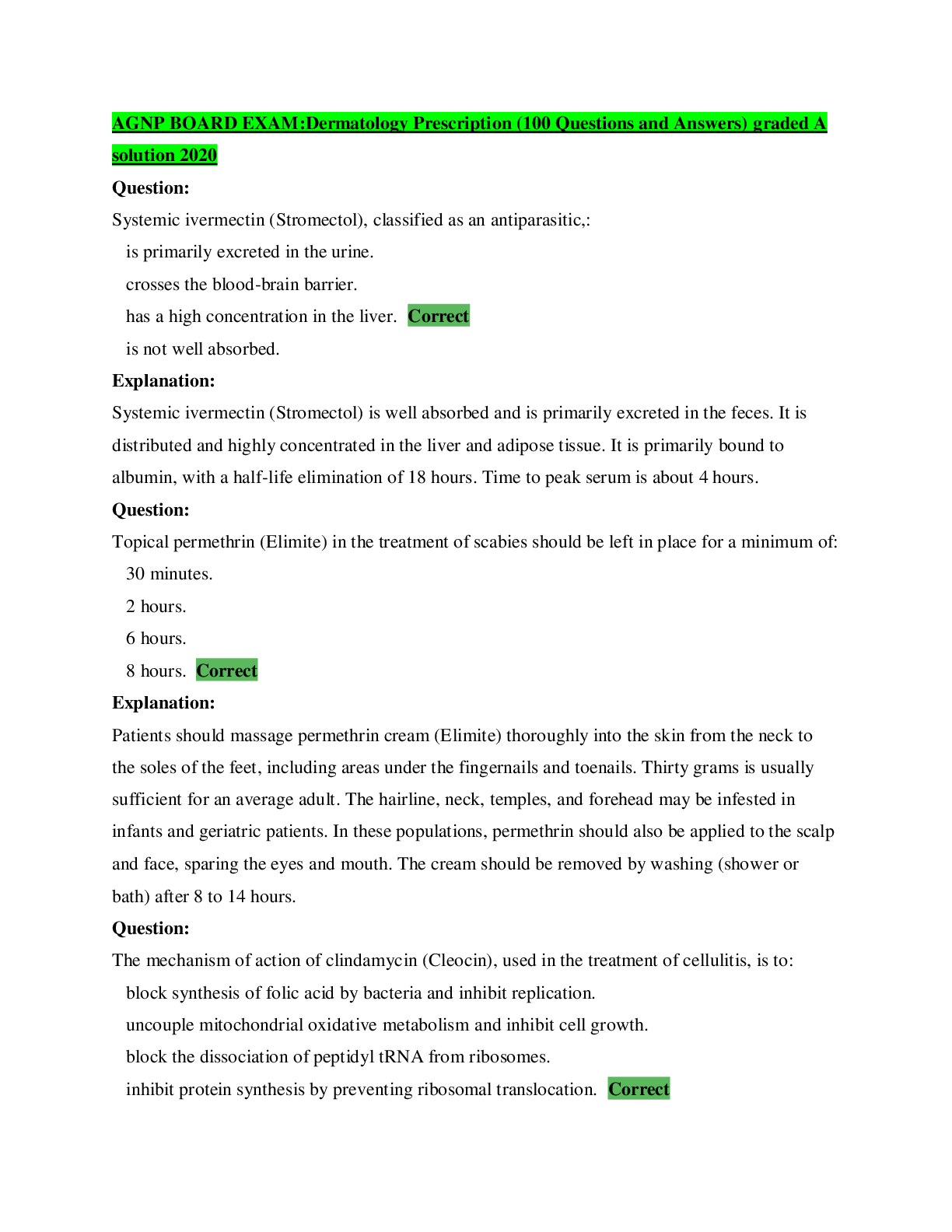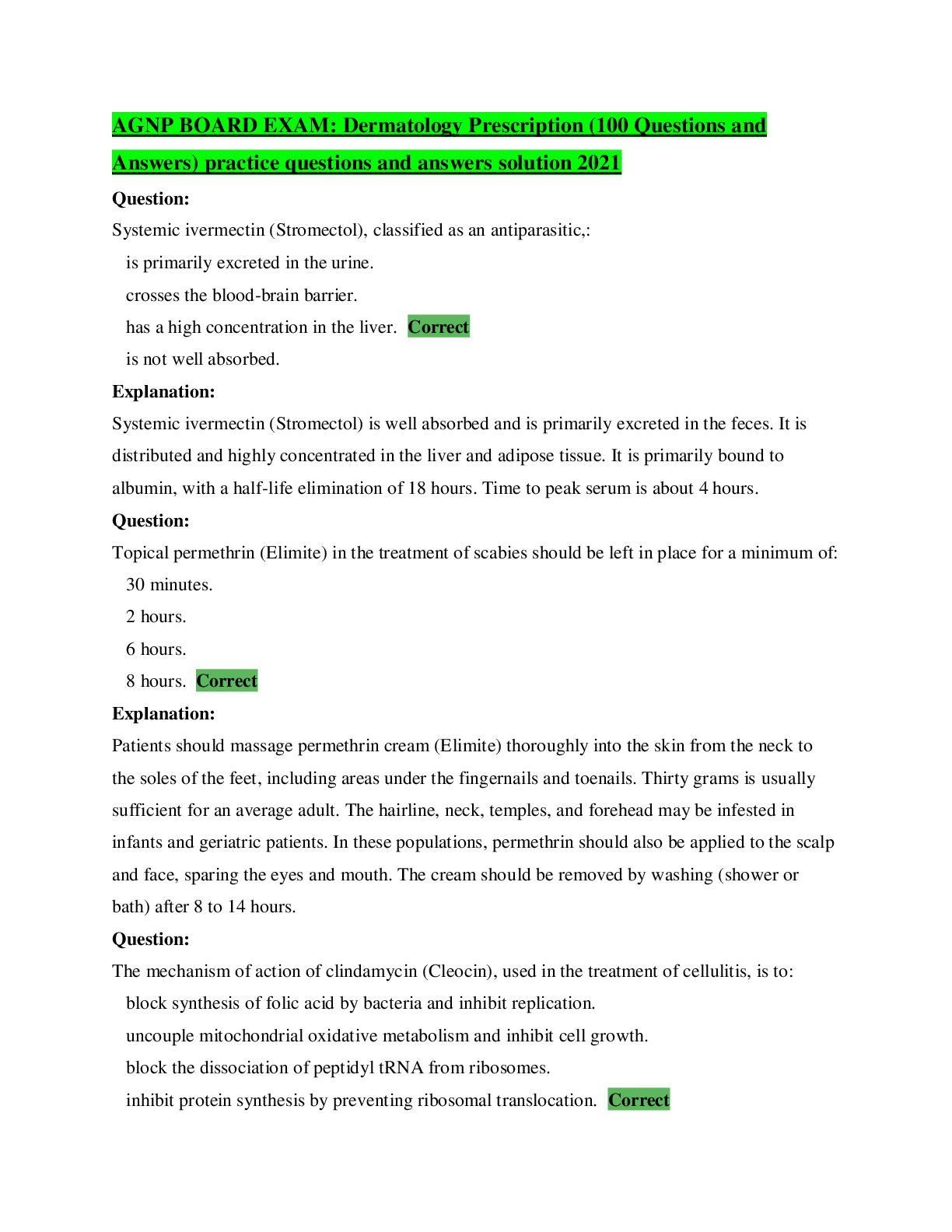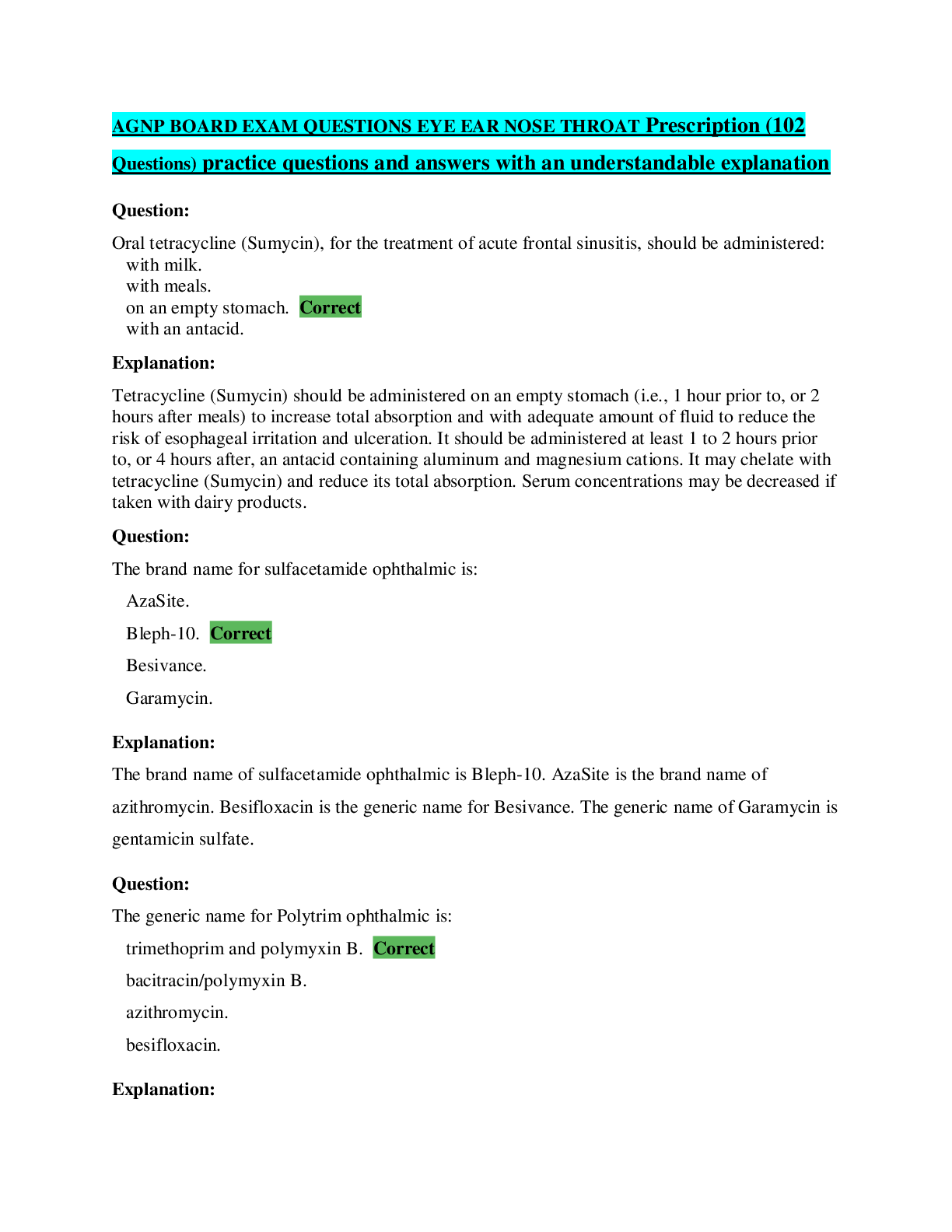*NURSING > QUESTIONS & ANSWERS > South University, Savannah NSG 6320 AGNP BOARD EXAM QUESTIONS Urology Assessment Already Passed (All)
South University, Savannah NSG 6320 AGNP BOARD EXAM QUESTIONS Urology Assessment Already Passed
Document Content and Description Below
AGNP BOARD EXAM QUESTIONS Urology Assessment ( 44 Questions) Question: In renal adaptation of the newborn, which one of the following statements is correct? The kidneys have an inability to concent... rate urine and adapt to fluid and electrolyte stress. Correct In the nephrons of the kidneys long tubules enhance the effectiveness of tubular reabsorption. The kidneys are fully capable of concentrating urine and maintaining fluid and electrolyte balance. The kidneys have the ability to increase the production of antidiuretic hormone (ADH) effectively. Explanation: In the neonate the kidneys are structurally complete but physiologically immature. The glomeruli have an inability to filter and concentrate urine, therefore glucose and amino acids escape and there is decreased ability to remove uric acid crystals which give the reddish appearance to the urine. There is an inability to adapt to fluid and electrolyte stress leading to loss of bicarbonate and poor reabsorption. This puts the neonate at increased risk of metabolic acidosis. The tubules are short/narrow which causes a problem with reabsorption. The nephrons function well within a month. ADH inhibits diuresis and the immature kidney causes an increased risk for dehydration. Question: What is the most common non-skin cancer in America? Uterine cancer Bladder cancer Cervical cancer Prostate cancer Correct Explanation: Prostate cancer is the most common non-skin cancer in America; 1 in 8 men will be diagnosed with it at some point in their lives. In fact, nearly 60% of all prostate cancers are diagnosed in men older than 65. Question: Patients with prior hypospadias surgery who develop slow and painful urination as well as prostatitis are experiencing symptoms of: neurogenic bladder. urethral stricture. Correct benign prostatic hyperplasia (BPH). prostate cancer. Explanation: A urethral stricture may occur in patients who have undergone hypospadias surgery and experience voiding symptoms such as urinary retention and straining to void. Neurogenic bladder symptoms include urinary retention and/or incontinence associated with other underlying chronic neurologic conditions (e.g., multiple sclerosis) or after spinal cord injury. Patients with BPH experience an increase in daytime frequency, nocturia, urinary incontinence, and terminal dribbling. Prostate cancer is usually asymptomatic but can sometimes present with storage, voiding, or irritative symptoms. Question: What is the average urine pH level? 4.5 6 Correct 7 8 Explanation: The average urine pH level is 5-6, acid pH is 4.5-5.5, and alkaline pH is 6.5-8. Question: Symptoms of proctitis may include all of the following except: left-sided abdominal pain. rectal pain. suprapubic pain. Correct tenesmus. Explanation: Proctitis is inflammation of the lining of the rectum leading to rectal pain, bleeding, and a continuous sensation to defecate (tenesmus). Additional symptoms may also include left-sided abdominal pain, diarrhea, pain with bowel movements, and a feeling of fullness in the rectum. Suprapubic pain is not generally associated with proctitis. Question: A useful mnemonic for elucidating causes of incontinence in the older adult is: STOOL. DIAPERS. Correct DRIP. URINE. Explanation: For elucidating causes of incontinence, two mnemonics may be helpful: DIAPERS, (Delirium, Infection, Atrophic urethritis/vaginitis, Pharmaceuticals, Excess urine output from conditions like hyperglycemia or heart failure, Restricted mobility, and Stool impaction) and DDRRIIPP (Delirium, Drug side effects, Retention of feces, Restricted mobility, Infection of urine, Inflammation, Polyuria, and Psychogenic). Question: Which of the following symptoms is NOT associated with nephrotic syndrome? Proteinuria Hyperlipidemia Lower leg edema Hyperalbuminosa Correct Explanation: Nephrotic syndrome is diagnosed by the presence of proteinuria, hyperlipidemia, edema, or swelling (usually in the legs, feet, or ankles and less often in the hands or face), and hypoalbuminemia. Question: In afebrile patients who experience intermittent sharp flank pain in addition to gross hematuria, further testing would be indicated for: pelvic inflammatory disease (PID). pyelonephritis. nephrolithiasis. Correct urethritis. Explanation: The majority of patients with symptomatic nephrolithiasis have intermittent flank pain/renal colic in addition to gross or microscopic hematuria. In the absence of infection, fever is unusual in patients with nephrolithiasis. Abdominal or pelvic pain and fever are the most common clinical findings in patients with pelvic inflammatory disease (PID), although dysuria may also be present. Pyelonephritis often presents with flank pain, fever, and pyuria. Symptoms of urethritis include dysuria, pyuria, or burning with urination. Flank pain or hematuria is not present in urethritis. Question: After running a 5K race, a 35-year-old man presents with complaints of muscle pain in the shoulders, weakness in both legs, and dark brown urine. These findings are consistent with: a urinary tract infection (UTI). rhabdomyolysis. Correct acute renal failure. renal calculi. Explanation: Rhabdomyolysis is a serious syndrome resulting from a direct or indirect muscle injury. It results from death of muscle fibers and release of their contents into the bloodstream, leading to renal failure. Exertional activity such as running a marathon or participating in strenuous exercises can cause rhabdomyolysis. Creatinine kinase (CK) is the most reliable and sensitive marker to indicate rhabdomyolysis or severe muscle breakdown. Question: When testing for pyelonephritis, the exam technique of percussing the back over the kidney that produces flank pain is called: Murphy's sign. psoas sign. Pasternacki's sign. Correct Rovsing’s sign. Explanation: Costovertebral angle tenderness (CVA), also known as Pasternacki's sign (Murphy's punch or Goldflam's sign), is a medical test in which findings of pain are elicited by percussion of the back over either kidney when infection is present. Murphy's sign assesses for cholecystitis. Murphy's sign is positive if hypersensitivity to deep palpation in the subcostal area occurs when a patient with gallbladder disease takes a deep breath. Psoas sign indicates irritation to the iliopsoas group of hip flexors in the abdomen, and consequently indicates that the inflamed appendix is retrocecal in orientation. Rovsing's sign indicates peritoneal irritation. If palpation of the left lower quadrant of a person's abdomen increases the pain felt in the right lower quadrant, the patient is said to have a positive Rovsing's sign and may have appendicitis. Question: A form of urinary incontinence that is characterized by the involuntary release of urine from a full bladder in the absence of any need to urinate is called: stress incontinence. urge incontinence. overflow incontinence. Correct functional incontinence. Explanation: Overflow incontinence is a form of urinary incontinence that is characterized by the involuntary release of urine from a full bladder in the absence of any need to urinate. This condition occurs in people who have a blockage of the bladder outlet (benign prostatic hyperplasia, prostate cancer, or narrowing of the urethra), or when the muscle that expels urine from the bladder is too weak to empty the bladder normally. Stress incontinence, also known as effort incontinence, is due essentially to insufficient strength of the pelvic floor muscles to prevent the passage of urine, especially during activities that increase intra-abdominal pressure, such as coughing, sneezing, or bearing down. Urge incontinence is involuntary loss of urine occurring for no apparent reason while suddenly feeling the need or urge to urinate. Functional incontinence is a form of urinary incontinence in which a person is usually aware of the need to urinate, but for one or more physical or mental reasons is unable to hold urine. Question: One cause of proctitis could be related to: gastritis. frequent anal intercourse. Correct cirrhosis. pancreatitis. Explanation: Proctitis is inflammation of the lining of the rectum leading to rectal pain, bleeding, and a continuous sensation to defecate. Causes may include: inflammatory bowel disease, sexually transmitted infections, radiation therapy, and frequent anal intercourse. Question: An infection or irritation of the bladder that leads to pain on urination is called: polyuria. dysuria. Correct urgency. incontinence. Explanation: An infection or irritation of the bladder that leads to pain on urination is called dysuria. Polyuria is a production of abnormally large volumes of dilute urine. Urinary urgency is a sudden, compelling urge to urinate. Urinary frequency or incontinence is the need to urinate more often than usual. Question: Symptoms of fever, chills, flank pain, costovertebral angle tenderness (CVA), and vomiting suggest: pelvic inflammatory disease (PID). pyelonephritis. Correct nephrolithiasis. urethritis. Explanation: Symptoms of pyelonephritis include flank pain, fever, costovertebral angle tenderness (CVA), and vomiting. Pelvic pain and fever are the most common clinical findings in patients with pelvic inflammatory disease (PID), however, CVA tenderness is not found. The majority of patients with symptomatic nephrolithiasis have flank pain/renal colic in addition to gross or microscopic hematuria. In the absence of infection, fever is unusual in patients with nephrolithiasis. Symptoms of urethritis include dysuria, particularly those with pyuria on urinalysis, but rarely causes fever or CVA tenderness. Question: Which of the following substances is found in the urine of a child suspected of having post streptococcal glomerulonephritis? Blood and protein Correct Bacteria and ketones Glucose and white blood cells Casts and mucous threads Explanation: With post streptococcal (strep) glomerulonephritis, a child may have a history of a recent strep infection (pharyngitis or impetigo). Proteinuria is secondary to altered glomerular structure and functioning. Gross hematuria causes the urine to be teacolored. Bacteria, white blood cells and mucus can be seen with urinary tract infections. Glucose and ketones present in the urine may be associated with diabetes. Question: A significant increase in 24-hour urine volume that exceeds 3 liters is called: polyuria. Correct dysuria. urgency. frequency. Explanation: Polyuria refers to a significant increase in 24-hour urine volume that exceeds 3 liters. Question: The findings of mucopurulent endocervical discharge and cervical motion tenderness on pelvic examination are strongly suggestive of: pelvic inflammatory disease (PID). Correct pyelonephritis. nephrolithiasis urethritis. Explanation: Abdominal or pelvic pain and fever are the most common clinical findings in patients with pelvic inflammatory d [Show More]
Last updated: 2 years ago
Preview 1 out of 15 pages

Buy this document to get the full access instantly
Instant Download Access after purchase
Buy NowInstant download
We Accept:

Reviews( 0 )
$13.00
Can't find what you want? Try our AI powered Search
Document information
Connected school, study & course
About the document
Uploaded On
Apr 22, 2022
Number of pages
15
Written in
Additional information
This document has been written for:
Uploaded
Apr 22, 2022
Downloads
0
Views
119

.png)






















